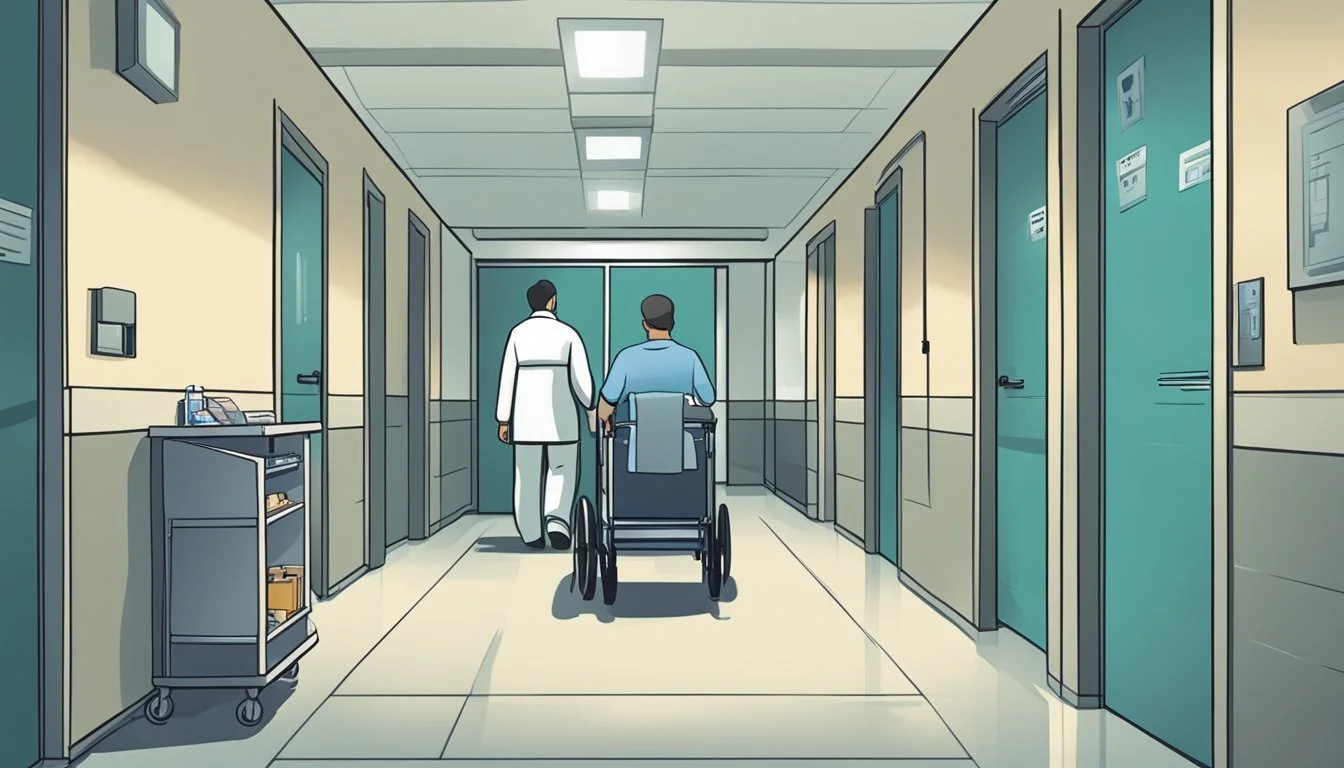First, Do No Harm: Michael Swango and the Betrayal of Medical Trust
A Chilling Tale of a Doctor Turned Serial Killer
The phrase "First, do no harm" is a fundamental principle of medical ethics. It encapsulates the obligation of healthcare professionals to prioritize patient safety and well-being above all else. Yet, the case of Michael Swango, a former physician turned serial killer, starkly illustrates how this sacred trust can be betrayed.
Michael Swango's actions represent one of the most egregious breaches of medical ethics in modern history. Over the course of two decades, Swango is believed to have poisoned and killed up to 60 patients and colleagues, exploiting his position as a doctor to carry out these heinous acts. His case not only shocked the medical community but also raised serious questions about the safeguards in place to protect patients from dangerous practitioners.
Swango's crimes highlight the critical importance of trust in healthcare settings. When patients seek medical care, they place their lives in the hands of professionals, expecting competence, compassion, and adherence to ethical standards. The betrayal of this trust can have far-reaching consequences, potentially eroding public confidence in the entire healthcare system.
The Early Career of Michael Swango
Michael Swango's early medical career was marked by academic success coupled with disturbing behavior that raised red flags. His path from promising student to suspected killer unfolded gradually as colleagues began to notice troubling patterns.
Medical Education and Red Flags
Swango enrolled at Southern Illinois University School of Medicine in 1979. He excelled academically, graduating in 1983. During his time as a student, Swango displayed an unusual fascination with death and dying patients.
Classmates noted his tendency to volunteer for morgue duty and his eagerness to pronounce patients dead. Some found his demeanor around terminally ill patients unsettling. Despite these oddities, Swango's technical skills and knowledge impressed many of his instructors.
In 1983, Swango began an internship at Ohio State University Medical Center. Nurses soon became wary of his presence, noticing that patients often became violently ill after he visited them.
First Suspicions and Investigations
By 1984, staff at Ohio State grew increasingly suspicious of Swango. Several patients died unexpectedly on his shifts. Nurses reported seeing him inject substances into IV bags.
The hospital launched an internal investigation but found no conclusive evidence of wrongdoing. They chose not to renew Swango's contract, citing poor bedside manner.
Swango moved on to other medical positions, often using falsified credentials. As he changed jobs frequently, a pattern emerged of patient deaths and illnesses following his care. However, inadequate background checks and poor communication between institutions allowed him to continue practicing medicine for years.
Healthcare Systems and Professional Trust
Trust forms the foundation of effective healthcare delivery. It enables patients to confide in providers and follow treatment plans. However, breaches of trust can have far-reaching consequences.
Fiduciary Trust in Healthcare Providers
Healthcare providers have a fiduciary duty to act in patients' best interests. This responsibility encompasses medical decision-making, confidentiality, and ethical conduct. Patients rely on doctors and nurses to use their specialized knowledge for beneficial purposes.
Trust in healthcare providers correlates with positive outcomes. Patients who trust their doctors are more likely to:
Disclose important health information
Adhere to treatment regimens
Seek timely medical care
Report higher satisfaction with services
When providers honor this trust, it strengthens the patient-provider relationship and improves overall care quality.
Impact of Negative Medical Experiences
Negative experiences can erode patient trust in healthcare systems. Examples include:
Medical errors or negligence
Privacy breaches
Lack of communication
Perceived indifference from staff
These incidents may lead to:
Delayed care-seeking behavior
Non-adherence to medical advice
Switching healthcare providers
Negative word-of-mouth about institutions
Research shows that institutional betrayal in healthcare settings affects 66% of patients. This betrayal predicts lower trust in individual physicians, doctors in general, and healthcare organizations.
Rebuilding trust after negative experiences requires transparency, accountability, and consistent demonstration of patient-centered care. Healthcare systems must prioritize these elements to maintain public confidence.
The Betrayal of Patient Trust
Michael Swango's actions and the healthcare institutions that enabled him shattered the fundamental trust between patients and medical professionals. This breach had far-reaching consequences for individuals and the medical system as a whole.
Swango's Path of Destruction
Michael Swango, a doctor turned serial killer, exploited his position to harm countless patients. He poisoned colleagues and patients across multiple hospitals in the United States and abroad. Swango's medical career spanned over a decade, despite suspicious deaths following him from institution to institution.
His actions went beyond individual murders. Swango systematically betrayed the trust placed in him as a healthcare provider. Vulnerable patients, expecting care and healing, instead became victims of his lethal intentions.
Institutional Betrayal and Its Consequences
Healthcare organizations failed to protect patients from Swango's deadly behavior. Hospitals overlooked warning signs and allowed him to continue practicing medicine. This institutional betrayal compounded the harm done to patients and their families.
The consequences of this systemic failure were severe:
Decreased trust in healthcare providers and organizations
Heightened patient anxiety and fear
Reluctance to seek necessary medical care
Long-lasting trauma for survivors and victims' families
Research shows institutional betrayal in healthcare settings can lead to:
• Lower adherence to medical advice • Fewer doctor visits, even when needed • Increased disengagement from the healthcare system
These impacts highlight the critical importance of robust patient safety measures and accountability in medical institutions.
Legal and Ethical Implications
Michael Swango's case exposed critical flaws in medical oversight and raised profound questions about patient safety. His actions violated fundamental ethical principles and legal standards governing medical practice.
The Law vs. Medical Malpractice
Medical malpractice laws aim to protect patients and hold physicians accountable for negligence. In Swango's case, his actions went far beyond negligence into criminal territory. He faced multiple felony charges, including murder and fraud.
Prosecutors had to prove Swango acted with intent to harm patients. This differentiated his case from typical malpractice suits focused on accidents or errors. His deliberate poisoning of patients violated criminal statutes as well as medical regulations.
Hospitals that employed Swango faced potential liability for inadequate background checks and supervision. This highlighted the need for more rigorous hiring practices and monitoring of medical staff.
The Ethics of Medical Practice
Swango's actions represented an extreme betrayal of medical ethics. The Hippocratic Oath's principle of "first, do no harm" forms the foundation of ethical medical practice.
Physicians are entrusted with immense responsibility for patient well-being. This trust relies on doctors prioritizing patient interests above all else. Swango's case demonstrated the catastrophic consequences when this ethical duty is violated.
Medical ethics emphasize respect for patient autonomy and informed consent. By secretly poisoning patients, Swango denied them the right to make decisions about their own care.
The case prompted reexamination of ethical guidelines for reporting concerns about colleagues' fitness to practice. Many felt earlier intervention could have prevented deaths.
Patient Safety and Risk Factors
Patient safety depends on identifying potential risks and implementing robust systems to prevent harm. Healthcare organizations play a crucial role in fostering trust through transparent practices and rigorous safety protocols.
Identifying and Mitigating Risks
Healthcare facilities must proactively assess potential dangers to patients. Common risks include medication errors, hospital-acquired infections, and surgical complications. To mitigate these, hospitals implement:
Electronic health records to reduce prescription mistakes
Strict hand hygiene protocols for staff
Surgical safety checklists before procedures
Regular safety audits help identify weak points in processes. Staff training on error reporting encourages a culture of openness. Involving patients in their care decisions also reduces risks.
Healthcare Systems' Role in Patient Trust
Trust forms the foundation of effective healthcare. Systems can build trust through:
Clear communication about treatments and potential risks
Transparency in sharing performance data and safety records
Prompt investigation and disclosure of adverse events
Establishing patient advocacy offices provides a channel for concerns. Implementing a "just culture" approach balances accountability with learning from mistakes. This creates an environment where staff feel safe reporting issues without fear of punishment.
Regular patient satisfaction surveys help gauge trust levels. Healthcare systems must act on feedback to continually improve safety and patient experiences.
Psychosocial Aspects of Patient Care
Patient care extends beyond physical treatment to encompass psychological and social factors. These elements play a crucial role in healing and overall well-being.
The Role of Social Support
Social support significantly impacts patient outcomes. Family, friends, and community networks provide emotional comfort and practical assistance during illness or recovery.
Studies show patients with strong social ties often experience faster healing and better adherence to treatment plans. Healthcare providers can encourage patients to engage their support systems.
Support groups connect individuals facing similar health challenges. These groups offer a sense of community and valuable coping strategies.
Healthcare institutions can facilitate social support by implementing family-centered care policies and creating welcoming spaces for visitors.
Trust and Disengagement from Health Care
Trust forms the foundation of effective patient-provider relationships. When trust erodes, patients may disengage from healthcare services.
Factors that damage trust include:
Poor communication
Perceived lack of empathy
Medical errors
Long wait times
Billing disputes
Disengagement can lead to delayed care-seeking and non-adherence to treatment plans. This puts patients at risk for worsened health outcomes.
To build trust, providers should:
Practice active listening
Involve patients in decision-making
Maintain transparency about procedures and costs
Follow up consistently
Address concerns promptly
Healthcare systems can implement patient feedback mechanisms to identify and address trust issues proactively.
The Impact of Swango's Actions on Public Health
Michael Swango's crimes shook the foundations of medical trust and patient safety. His actions reverberated through healthcare systems, prompting changes in screening processes and raising public awareness about the potential for abuse within medical institutions.
Public Awareness and Response
Swango's case brought unprecedented attention to patient safety issues. Media coverage exposed vulnerabilities in hospital security and background checks for medical personnel. This heightened scrutiny led to increased public demand for transparency in healthcare hiring practices.
Many hospitals implemented stricter vetting procedures for medical staff. Background checks became more thorough, often including cross-referencing with multiple state medical boards and law enforcement agencies.
Patient advocacy groups gained traction, pushing for stronger safeguards against medical misconduct. Some organizations launched campaigns to educate the public about patient rights and how to recognize potential red flags in healthcare settings.
Trust in Healthcare Post-Swango
The revelation of Swango's crimes dealt a significant blow to public trust in healthcare organizations. Patients became more wary of medical professionals, especially in hospital settings where Swango had operated undetected for years.
Healthcare institutions faced the challenge of rebuilding patient confidence. Many implemented new policies to increase accountability and patient safety. These included:
Enhanced reporting systems for suspicious behavior
Regular audits of medication administration
Improved communication channels between hospitals and medical boards
Despite these efforts, lingering doubts persisted. Some patients reported increased anxiety during hospital stays or when starting treatment with new doctors. This erosion of trust highlighted the long-lasting impact of Swango's actions on public health perceptions.
Long-Term Effects on Victims
Victims of medical betrayal often face profound and lasting psychological consequences. These effects can range from mental health challenges to resilience and recovery journeys.
Mental Health Outcomes of Betrayal
Survivors of medical betrayal frequently experience depression, anxiety, and posttraumatic stress. These conditions can persist long after the initial trauma. Depression may manifest as feelings of hopelessness and loss of interest in daily activities.
Anxiety often presents as heightened fear of medical procedures or distrust of healthcare providers. Some victims develop panic attacks when faced with medical situations.
Posttraumatic stress can lead to intrusive thoughts, nightmares, and avoidance of medical settings. This may result in neglect of personal health needs.
Many survivors struggle with guilt or shame, questioning if they could have prevented the betrayal. These feelings can impact self-esteem and relationships.
Resilience and Recovery
Despite the challenges, many victims demonstrate remarkable resilience. Some find strength through support groups and peer connections.
Therapy, particularly trauma-focused approaches, can be beneficial. Cognitive-behavioral therapy helps survivors process their experiences and develop coping strategies.
Some victims channel their experiences into advocacy work. They may raise awareness about patient safety or push for systemic changes in healthcare.
Rebuilding trust in medical professionals is a crucial part of recovery. This process often involves small steps, such as finding a trusted primary care physician.
Mindfulness and stress-reduction techniques can aid in managing anxiety and PTSD symptoms. These practices help survivors regain a sense of control over their health.
Preventing Future Betrayals
The Michael Swango case exposed critical vulnerabilities in medical institutions and training. Addressing these weaknesses requires reforms in medical education and institutional practices to prioritize patient safety and rebuild trust.
Educational Reforms in Medical Training
Medical schools must strengthen ethics training and screening processes. Curricula should emphasize the sacred trust between doctors and patients. Students need to learn how to recognize and report concerning behaviors in peers and superiors. Background checks and psychological evaluations for applicants can help identify red flags early.
Mentorship programs pairing students with experienced physicians can reinforce ethical standards. Case studies of medical misconduct provide valuable learning opportunities. Schools should teach proper documentation and reporting procedures for patient safety issues.
Institutional Changes and Patient Advocacy
Hospitals must implement robust systems for tracking adverse patient outcomes. This includes analyzing patterns across departments and practitioners. Anonymous reporting channels allow staff to voice concerns without fear of retaliation.
Patient advocacy offices can serve as independent watchdogs within medical facilities. These offices investigate complaints and ensure follow-up action. Clear communication protocols between shifts and departments help prevent information gaps.
Institutions should conduct regular safety culture assessments. Results can identify areas for improvement in policies and practices. Ongoing training reinforces best practices for all staff members.







